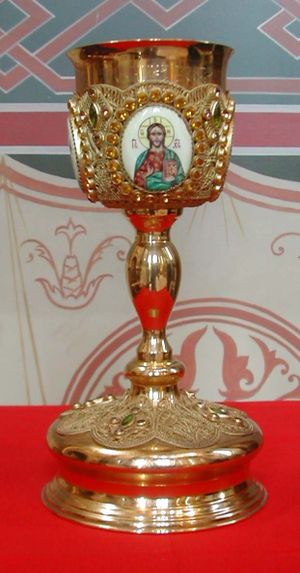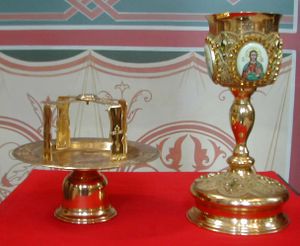Difference between revisions of "Chalice"
m (interwiki mk) |
(added image) |
||
| Line 3: | Line 3: | ||
Before the Divine Liturgy begins, a service called the [[proskomedia]] is conducted at a [[table of preparation]] or [[prothesis]] at the side of the [[altar]], during which the Holy Gifts are prepared for Communion. As [[prayer]]s are recited the chalice is filled with wine and from the prosphora a '''Lamb''' is cut and placed on the paten. The prayers include commemorations from the faithful for loved ones, both living and dead. During the [[Great Entrance]] these Gifts are brought to the altar table where by joining the [[Lamb]] with the wine the celebrant calls for the bread and wine to be the Body and Blood of Christ for Communion. | Before the Divine Liturgy begins, a service called the [[proskomedia]] is conducted at a [[table of preparation]] or [[prothesis]] at the side of the [[altar]], during which the Holy Gifts are prepared for Communion. As [[prayer]]s are recited the chalice is filled with wine and from the prosphora a '''Lamb''' is cut and placed on the paten. The prayers include commemorations from the faithful for loved ones, both living and dead. During the [[Great Entrance]] these Gifts are brought to the altar table where by joining the [[Lamb]] with the wine the celebrant calls for the bread and wine to be the Body and Blood of Christ for Communion. | ||
[[Image:Discos Chalice.jpg|thumb|left|Chalice with Diskos]] | [[Image:Discos Chalice.jpg|thumb|left|Chalice with Diskos]] | ||
| + | [[Image:Chalice-2.jpeg|left|thumb|100px|Chalice of the Ipatevsky Monastery, Kostroma, 1911.]] | ||
Communion begins among the higher [[clergy]], [[bishop]]s, [[priest]]s, and [[deacon]]s, before the Lamb is mixed with the wine for communion of the laity. Communion of the [[laity]] is usually by spoon directly from the chalice to the communicant. Except for a portion of the communion that may be held in reserve for communion of the sick before the next Divine Liturgy, the remaining portion of the Body and Blood of Christ is consumed by the clergy at the conclusion the service | Communion begins among the higher [[clergy]], [[bishop]]s, [[priest]]s, and [[deacon]]s, before the Lamb is mixed with the wine for communion of the laity. Communion of the [[laity]] is usually by spoon directly from the chalice to the communicant. Except for a portion of the communion that may be held in reserve for communion of the sick before the next Divine Liturgy, the remaining portion of the Body and Blood of Christ is consumed by the clergy at the conclusion the service | ||
Revision as of 16:18, April 6, 2011
Before the Divine Liturgy begins, a service called the proskomedia is conducted at a table of preparation or prothesis at the side of the altar, during which the Holy Gifts are prepared for Communion. As prayers are recited the chalice is filled with wine and from the prosphora a Lamb is cut and placed on the paten. The prayers include commemorations from the faithful for loved ones, both living and dead. During the Great Entrance these Gifts are brought to the altar table where by joining the Lamb with the wine the celebrant calls for the bread and wine to be the Body and Blood of Christ for Communion.
Communion begins among the higher clergy, bishops, priests, and deacons, before the Lamb is mixed with the wine for communion of the laity. Communion of the laity is usually by spoon directly from the chalice to the communicant. Except for a portion of the communion that may be held in reserve for communion of the sick before the next Divine Liturgy, the remaining portion of the Body and Blood of Christ is consumed by the clergy at the conclusion the service


